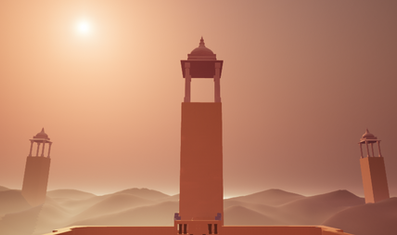Trikaya
Details
Trikaya is a 1st-person fantasy puzzle game I worked on as a level designer in a group of ten teammates for a Capstone project at SMU Guildhall. The player takes the role of a young explorer of an ancient temple trying to reassemble a wand that lets them control wind, earth, and fire magic. We published it to Steam in January, 2021, where we garnered "Very Positive" reviews and made it to the front page of the free section. I worked on level design, gameplay design, and environmental design in this project.
Game Statistics:
-
Engine: Unreal 4
-
Platform: Windows
-
Genre: Puzzle-Adventure
-
Team Size: 10
-
Development Time: 6 months
Level Design
LD Team
Duties
-
Designed levels and puzzles with supervision and input from Garrett Pfingston, the lead level designer, and Ronald Wang, the Game Designer.
-
Designed and built maps, gameplay moments, and puzzles for Proof of Concept milestones, as well as the map we used for the Vertical Slice milestone.
-
Designed and built levels 2 and 3 of the three primary levels of the game, in which the player learns to use Earth and Fire magic, respectively.
-
-
Fixed design bugs and refined gameplay across the game at each milestone, touching every space by the end.
-
Inserted Easter eggs pertaining to other capstone games from our cohort.
Breakdown
I began my role as level designer in the planning phase of the development of Trikaya, and kept that role until we shipped the game. I prototyped gameplay with Ronald, Garrett and fellow level designer Keval Shreyas, working in pre-production to develop puzzle moments for the different magical abilities we were exploring, first on paper and then in Unreal 4. When full production began at the beginning of fall 2020, I designed the general overview of the level structure with Shreyas and the leads, then took levels 2 and 3 from Whitebox to RTM. I constantly iterated on the levels to make sure we were teaching players how to use each element clearly, making use of previous elements players had access to, and keeping gameplay along our intended difficulty curve.
Pre-Production: Whiteboard Puzzles and Planning
-
Shreyas, Garrett, Ronald, and I developed the general concept for the gameplay, in which the player would use various elemental magical abilities to solve puzzles, and we workshopped different gameplay moments and interactable objects that we could use as building blocks to provide obstacles and solutions to the player. We generally developed these "proof of concept" ideas through drawing levels and lists on nearby whiteboards. Below are examples of proof of concept puzzles and layouts
Pre-Production: Proof of Concept Gameplay
-
Once we finished figuring out what puzzle pieces and powers we had to play with, we needed to show the stakeholders what a section of gameplay would look like in the Proof of Concept Gameplay milestone. Since Shreyas was busy doing technical design at the time, I designed the puzzles and general layout of this space, then built it in Unreal 4, with Shreyas helping me build it in on a separate stream.
-
I first built a digital map, which was approved by the leads, and then built the level in Unreal 4 using art assets and interactables that the artists and programmers had ready for us at the time. It's a simple design, but it uses the Earth power to shoot projectiles from the earth patches and create pillars, Wind to pull blocks into place and swing the chandelier, and Fire to destroy the spool that releases the chandelier into position.

-
We then modified the level as we built it to accommodate the assets we had available in time, as well as reflecting gameplay needs, such as adding another pullable block (elephant statue) earlier in the level to teach the player how to use them in isolation.
-
(Note: the lighting below was a work in progress at this stage of development)


Production: Level 2
-
Once we got into production, we needed to show off a level for the Vertical Slice milestone. So I came in and constructed the layout and puzzle sequence of level 2, in which the player first learns how to use the Earth ability. They can use this power to shoot projectiles and create walkable earth pillars.
-
I used the ground floor of the outdoor space to teach the player how to break and move objects with the dirt patch projectile.
-
Then I used broken sections of rafters above the space to teach the player how to use Earth pillars to build bridges across gaps.




Production: Level 3
-
Whereas Level 2 was handed to me for Vertical Slice and I got to refine it periodically, I had control of Level 3 throughout production.
-
Level 3 taught the player how to use the Fire ability, which was characterized by illumination and destruction.
-
Early puzzles in the level teach players how to use the "Ore Cube", a small Wind-pullable object that the player can turn off and on with Fire. If this object is "on" and nearby a magical wall, it could make the wall tangible, blocking objects and the player.
-
Then the player learns they can destroy Earth pillars with Fire, letting them be retracted or enlarged at will. And, as in POCG, the player can also use Fire to destroy spools of rope that will lower chandeliers into more convenient positions to act as environmental wrecking balls.
-
-
As the third of three primary levels of the game, the player






Production: General
-
I was involved the most in Level 2 and Level 3, but I touched every section in production as a level designer, fixing bugs, placing blocking volumes around static meshes, playtesting, refining designs, filling in clutter, adjusting lighting and LODs, etc.
-
For example:
-
Intro Area: Contextualized player start, executed wand artifact movement, fixed sightline errors
-
Hub Area: Realigned space with levels, fixed construction and sightline errors, decorated space
-
Level 1: Designed and blocked out the first overall layout, fixed puzzle bugs, decorated and rebuilt transition spaces
-
Level 2 Transition Space: Fixed build errors, tested bugs, redecorated, rebuilt space to reflect new puzzle mechanics
-
Temple Sanctum: Fixed build and construction errors, iterated on puzzles
-
-
I also placed Easter Eggs throughout the level, taking into account player sightlines and difficulty to spot.

Space Smack Easter Egg (1/2)

Puzzle Box Palace Easter Egg

Curse That Magic Cat Easter Egg

Crystal Call Easter Egg (1/3)
Gameplay Design
LD Team
Duties
-
Designed elemental abilities and interactable objects in collaboration with Garrett Pfingston, the lead level designer, Keval Shreyas, my fellow level designer, programmers Spencer McKean, Sam Chu, and Rahul Gupta, as well as Ronald Wang, the Game Designer.
-
Collaborated in preproduction to brainstorm mechanics and built "playgrounds" to experiment with the ones developed by programmers based on LD asks.
-
Developed skill progression chart that would influence how levels were laid out and what players would have access to throughout the temple.
-
-
Playtested relentlessly to refine gameplay and "find the fun", both for individual mechanics and in the levels themselves.
Breakdown
We came into pre-production with a pitch for a game where players would explore an ancient temple using magical abilities to solve puzzles, so that gave us a lot of latitude to figure out what this game actually was. Since ancient temples come in a lot of unique flavors, we studied various world mythologies, including Tibetan, Chinese, and Egyptian, but we eventually decided to take inspiration from Indian culture and aesthetics. We studied the classical five elements of Hindu cosmology (water, fire, earth, air, and space/void) and developed gameplay around those elements, with the intention that the player could select from them at will. However, it quickly became apparent that five elements would take too long to introduce and develop as a small studio with limited time without sacrificing gameplay depth, so we narrowed our focus to three elements that showed the most promise: Earth, Wind, and Fire.
Pre-Production
-
We threw around a lot of ideas while we were trying to figure out what the game was. We started with classical Chinese elements, but we found we were getting more results we liked when we transitioned to Indian elements and aesthetics.
-
We started by coming up with ideas for powers on whiteboards, then we made speedmap puzzles using one or two powers at a time, to figure out which ones could produce more gameplay and worked well together.
-
The programmers built us prototype versions of some select powers that we tested and built quick levels around in Unreal 4 to show our stakeholders for preproduction milestones.
Wind
-
Wind began as the most promising elemental power in preproduction. The basic ability to "pull" objects linearly afforded endless puzzle opportunities when I was testing it out, and it became the cornerstone upon which we built our puzzles and interactables, as well as the first power players acquired in the game.
-
Wind could be used to pull elephant statues and ore cubes, trigger levers, swing chandeliers, turn off torches, and fling projectiles.

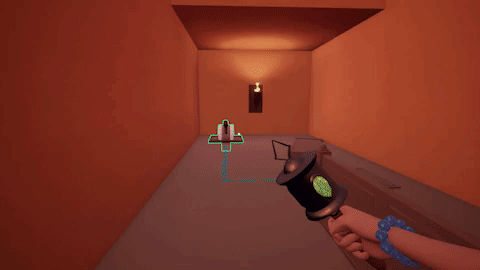
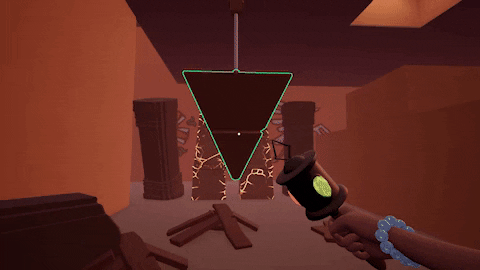
Earth
-
Earth was also an early power from pre-production, defined by its ability to "create". But initial versions of the power struggled with flexibility. We knew we wanted to create pillars the player could use as elevators, bridges, or ways of blocking objects, but we didn't have another use for it until later on, when we came up with the ability to create projectiles the player could fire with wind magic. Along with the ability to turn off fire-based objects, we decided it had enough flexibility to be the focus on the second level.
-
We ended up using Earth to create pillars, create projectiles, and turn off torches and ore cubes.
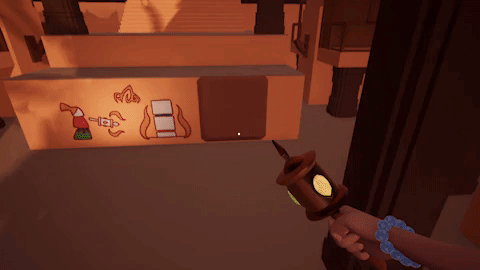
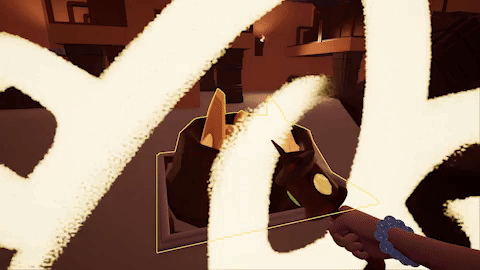
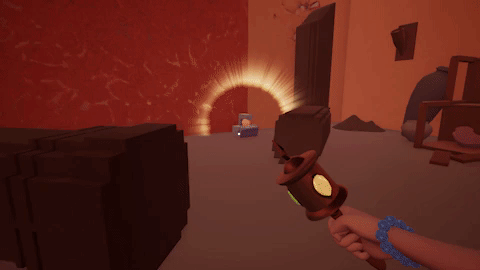
Fire
-
Fire was the trickiest power to design for. We knew that it had a solid niche for "destruction", but outright destruction can be a poor use case in puzzle games, since destruction tends to not be reversible unless you can go back in time or load frequent checkpoints.
-
So the second cornerstone of Fire we came up with was the ability to turn on "ore cubes", small magical sculptures that could make certain transparent walls and floors solid when they are nearby. This mechanic was the backbone of Level 3, where Fire is introduced as the third and final ability the player gets access to on their wand.
-
We also utilized Fire as a way to enable object capabilities, such as burning a rope to allow a chandelier to swing, as well as to complete Boolean functions of mechanics, such as letting players destroy earth pillars when before they could only create them.
-
In all, Fire could be used to burn ropes, destroy Earth pillars, turn on Ore Cubes, or light torches.
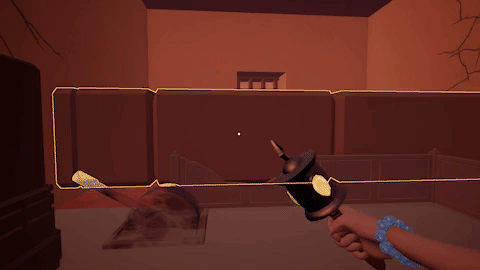
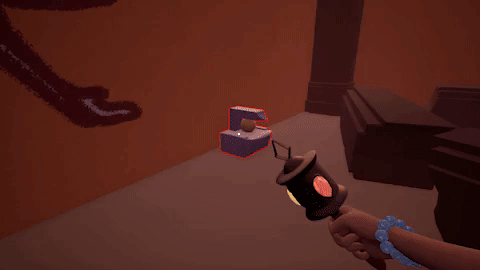
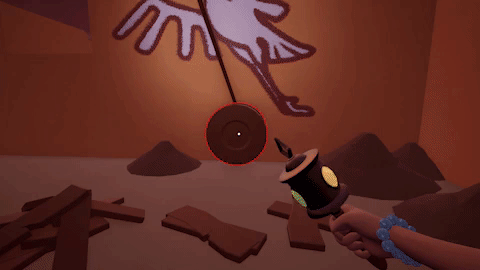
Interactable Objects
-
Though we had the broad strokes verbs of what we wanted the player to be able to do with our powers, it was the interactable objects that actually let them affect the world.
-
Some objects interacted with only one power but were fairly flexible, such as the elephant statues and levers. Other objects interacted with multiple powers, such as earth pillars and ore cubes. As the player gained more powers, objects of the latter type became more common.
-
As I worked on levels 2 and 3, I had to keep in mind what puzzles would be possible with and without and object's full capabilities, since one power would be available in one level, but not the other. The skill progression chart I created with Shreyas was a big help for keeping those straight.
-
-
Other objects couldn't be acted on directly by the player, but other interactable objects worked as intermediaries. For instance, breakable walls and pillars require elephants, chandeliers, or projectiles to be destroyed, while magical floors, levers, and barriers needed a lit ore cube nearby to solidify. These challenged the player to think several steps ahead and add complexity to our levels.
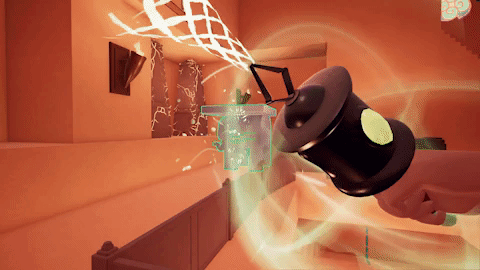
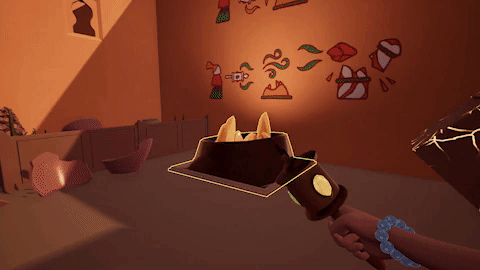
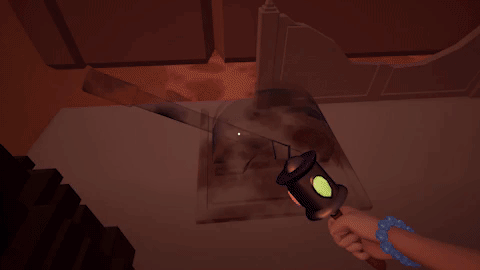
Environmental Design
LD Team
-
Designed and built the Dune Sea around the temple to contextualize the world and increase its aesthetic appeal, using the Unreal 4 terrain tools.
-
Worked with artists to decorate spaces, particularly Level 3 with the approval of our lead artist Yuanfang Liu.
Breakdown
The artists were "all hands on deck" during beta to make the game look good, but they didn't have the manpower to get everything done. So Yuanfang had me fill in the gaps. I arranged assets that the artists supplied in blank rooms of Level 3 to make the spaces feel formerly lived in, and I also provided a second pass on rooms that had to be rushed. I also realized in Alpha that we had a number of sightlines out of the map into an empty horizon, so I proposed we add a Dune Sea outside the map to make the temple location feel real. Since the artists were busy, the responsibility fell on me, so I created these dunes with the Unreal 4 terrain editor.
Dune Sea
-
Went through three passes of iteration, first to get the general structure with sightlines, the next to make the dunes more dramatic, and the final one to make them more realistic.
-
Problem areas that needed significant horizon blocking were the South (visible from the final stairs), Northeast (visible through the cinematic flythrough for Level 2), and North (visible from upper floors of the hub area).
-
It was also important to choose where not to work, since there wasn't time to set up a realistic desert throughout the entire map. Anywhere that the player couldn't see without noclipping was left on the cutting room floor.



Decoration
-
Primarily worked in the Level 3 dungeon area, as well as the transition space from the end of Level 3 to the hub. I worked autonomously most of the time, and when I needed Yuanfang's approval, I made sure to take as little of her time as possible.
-
Both over and under decoration were problems before I took over. Some areas had too little clutter, making them feel blank, while others were covered in decals in ways that didn't make sense for the space.
-
To fix these sections, I adhered to the artists' general style for the rest of Trikaya, practicing minimalism unless spaces needed:
-
Leading lines to guide the player forward
-
Light clutter to allude to the temple's steady decay
-
Thematic artwork for an area or ability
-


Retrospective
What went well
-
The team never lost heart, even though we encountered plenty of strife. As a result, we turned in a game we could be proud of.
-
The difficulty curve flowed nicely from one room to the next, with each space teaching the player what they needed to while smoothly ramping up the difficulty.
-
Got along well with teammates overall and trusted in their good work.
-
Producer kept team on task and on schedule, even when we had to add more than we anticipated due to stakeholder feedback.
What I learned
-
Optimization is a crucial part of development that must be considered from the very beginning of a project. Unreal also has some great tools to help with that.
-
It's essential to get on the same page as stakeholders and make sure you continue to be there throughout, even between milestone deadlines. Work gets lost if there is disagreement or misunderstandings between the two parties.
-
Every team is different, and certain structures work better for different situations. Pipelines and communication channels should be molded to fit the team, rather than the other way around.
-
It's important to acknowledge team problems early and in a constructive manner so they don't come back to hurt the game later in production.
-
Modular kits are great for level designers to build a space, but they aren't always ideal for optimization. Time needs to be allowed for artists to build more optimized custom spaces once the layout is determined.
-
If you are going to kill your darlings, do so early. Trikaya struggled with affordance issues with some of the interactables, but by the time we felt ready to let go and change some of the art assets to address this feedback, it was too late to change anything.















